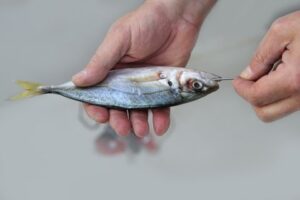Bait Hooking Position
WHAT IS BAIT HOOKING POSITION?
Seabirds are at greatest risk of becoming hooked and drowned when foraging in the ocean, during the short period between when hooks leave the vessel and when they sink beyond seabirds’ diving ranges. The faster the sink rate of baited hooks in longline fisheries, the less available these hooks are to foraging seabirds. The position of the hook in the bait affects the sinking speed and is therefore a small, but important, factor in mitigating bycatch. Simply by positioning the hook in either the head (of a fish) or tail (of a fish or squid) of the bait, the sink rate is increased, and the baited hook descends more quickly through the water column.

Source: www.liveoutdoors.com
CURRENT RESEARCH & USE
As yet, little to no quantitative research exists to label this as a specific ‘bycatch mitigation strategy’, perhaps because it is such a small adjustment. However, it must be noted that ACAP (the Agreement on the Conservation of Albatrosses and Petrels) have highlighted this as “best practice” in their 2019 review on reducing seabird bycatch.
This page was last updated on 12.02.21.
Interested in how this and other measures could mitigate bycatch in your fishery? Get in touch with us to collaborate or take part in a study.
